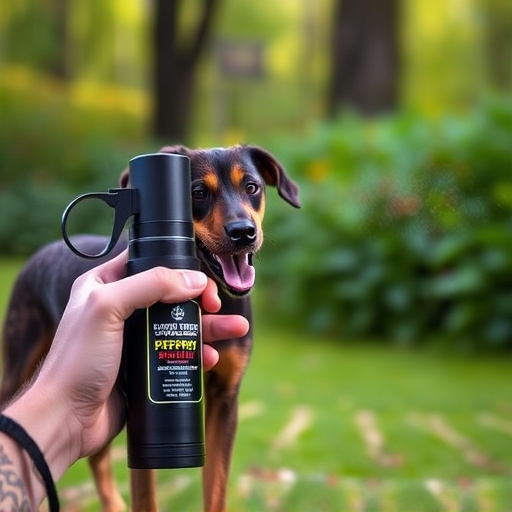Mace exposure in dogs causes health risks, requiring immediate action. Decontaminate pets using lukewarm water and gentle dog-safe detergent, focusing on facial areas. Remove contaminated clothing, avoid harsh soaps, and clean paws, ears, and trapped residue thoroughly. Seek veterinary care for specialized treatment and guidance to prevent long-term effects. Prevent future incidents by decontaminating, storing chemicals securely, using leashes outdoors, and educating about exposure signs.
Dog spray, or mace, can pose significant risks to your pet’s health if exposed. This article guides you through understanding the dangers of dog spray contact, detailing immediate actions to take after exposure, and offering safe decontamination techniques at home. We’ll explore when professional veterinary support is necessary and provide preventitive safety measures to keep your furry friend secure. Learn how to effectively decontaminate your pet after mace exposure and protect them from future incidents.
- Understanding Dog Spray Exposure Risks
- Immediate Actions After Mace Contact
- Safe Decontamination Techniques at Home
- Professional Help: When to Seek Veterinary Support
- Preventing Future Incidents: Safety Measures
Understanding Dog Spray Exposure Risks
Dog spray, also known as pepper spray, can pose significant risks to your pet’s health and well-being if they are exposed. Understanding these risks is crucial for any dog owner. When a dog is sprayed, the irritants can cause severe discomfort, including respiratory distress, inflammation, and even panic attacks. These symptoms can vary from mild irritation to more severe, potentially life-threatening reactions, especially in sensitive dogs or those with pre-existing health conditions.
Knowing what to do if your pet experiences Mace exposure is essential. Rapid decontamination is key; rinse the affected area thoroughly with water for at least 15 minutes. Seek veterinary assistance promptly, as they can provide specialized care and treatment options tailored to your dog’s needs. Remember, preventing exposure through proper training, supervision, and using protective gear is always better than dealing with the aftermath.
Immediate Actions After Mace Contact
If your dog comes into contact with mace spray, immediate action is crucial for decontaminating them and ensuring their safety. The first step is to remove any contaminated clothing or accessories and rinse the affected areas with plenty of water. This process helps to dilute the chemical agent and prevent further absorption.
Once rinsed, use a mild, dog-safe detergent to gently clean the fur and skin, ensuring thorough decontamination. It’s important to pay extra attention to facial areas, as mace spray can cause severe irritation or even temporary blindness if not properly removed. After cleaning, rinse again with water and pat dry with a soft towel. Keep an eye on your dog for any signs of distress or unusual behavior, and consult a veterinarian if needed, especially if symptoms persist or worsen.
Safe Decontamination Techniques at Home
If your pet has been exposed to dog spray, it’s crucial to act swiftly and safely decontaminate them at home before seeking professional veterinary care. Start by removing any contaminated clothing or bedding immediately. Rinse the affected area thoroughly with lukewarm water, ensuring no residue remains. Avoid using harsh soaps or detergents, as they can irritate your pet’s skin further.
For pets with fur, consider using a gentle pet-safe decontaminant solution recommended by veterinarians. Never use human de-icing products or other chemicals without consulting a vet first. Gently clean and dry the affected areas, paying close attention to facial paws, ears, and any nooks where spray might have been trapped. Remember, proper decontamination after Mace exposure is just as important as getting medical care for your pet’s overall well-being.
Professional Help: When to Seek Veterinary Support
If your dog has been exposed to mace or any other irritant spray, it’s crucial to act quickly and decisively. The first step should always be to remove the dog from the immediate area where the exposure occurred and take them to a safe, calm space. Next, promptly decontaminate your pet by washing their fur and skin with warm water and a mild, pet-safe soap. This process helps to eliminate any residual chemicals that might remain on their coat or skin.
Seeking professional veterinary support is essential if the symptoms persist or worsen. Veterinarians are equipped to handle such situations effectively. They can offer specialized treatment, recommend appropriate decontamination methods, and monitor your dog’s health to ensure no long-term effects from the exposure. Remember, timely intervention is key in ensuring your pet’s well-being after an incident involving irritant sprays.
Preventing Future Incidents: Safety Measures
After a dog spray incident, it’s crucial to take immediate steps to prevent future occurrences and ensure the well-being of your pet. The first step in mitigating risks is decontaminating your pet as soon as possible after exposure to mace or any similar chemical agent. Start by removing any contaminated clothing or accessories and rinsing their fur thoroughly with warm water. You can also use a mild, pet-safe detergent to help wash away any residual chemicals.
In addition to decontaminating your pet, it’s essential to create a safer environment for them. This includes storing dog spray and other potentially harmful substances out of reach, using enclosed areas or leashes when outdoors, and regularly inspecting your surroundings for any potential triggers. Educating yourself and your family about the signs of mace exposure in dogs can also be valuable in quickly addressing future incidents.
Dog spray, or mace, can be a dangerous substance if your pet is exposed. By understanding the risks and taking immediate action, you can effectively decontaminate your pet at home and prevent future incidents. Remember to seek professional veterinary support if symptoms persist or worsen, as proper care is essential for your pet’s well-being. Implementing safety measures and knowing how to properly decontaminate after mace exposure can help keep your furry friend safe and protected.
